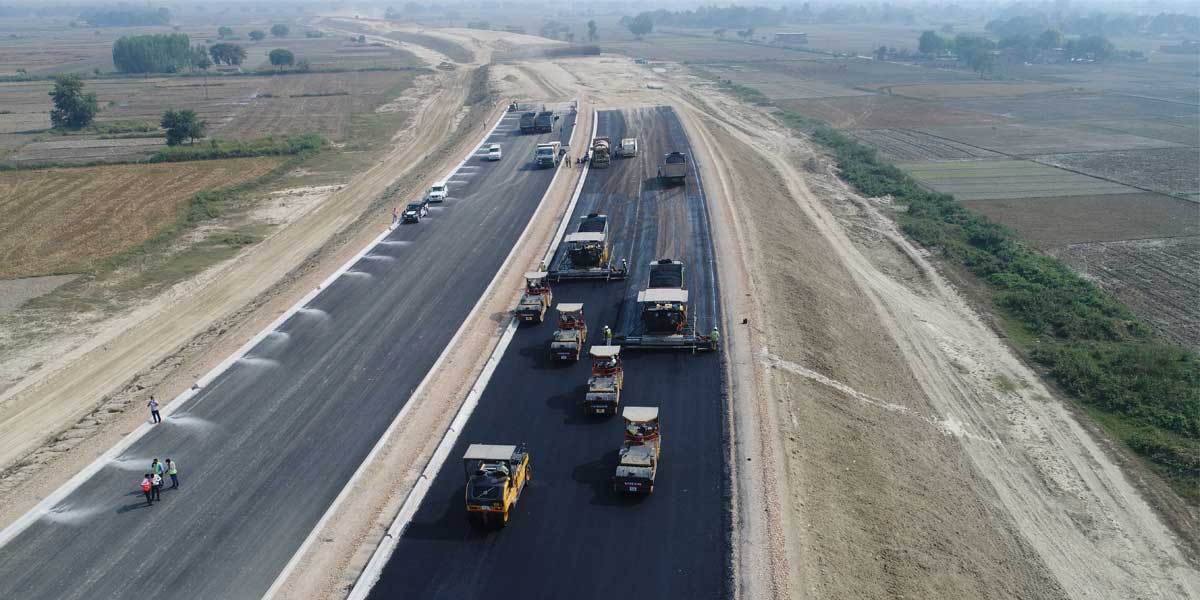Prior to the lockdown, the Indian market for compactors hovered between 3,500 and 5,000 units, and pavers at more than 500 per year on the back of road and highway connecting projects, coastal and port projects and expressways such as Bharatmala, Sagarmala and Pradhan Mantri Gram Sadak Yojna. Since then, there’s been significant change in what’s selling.
Choice matters
“Between 2019 and 2021 the share of pavers below 5.5m width has increased from 63 per cent to 69 per cent while the share of pavers of 9m has reduced from 9 per cent to 4 per cent,” shares H S Mohan, Chief Executive Officer, Infrastructure Equipment Skill Council (IESC). He believes this may have happened because contractors focus on quick procurement without evaluating new technologies, as their focus is speedy completion with most contractors subcontracting their job to complete the job quicker.
If new technology doesn’t get absorbed; current technology persists.
Essentially, the uptake of higher capacity pavers has reduced in recent years. To what extent do government guidelines, and project characteristics such as location and features impact the choice of paver and compactor?
First of all, “the government tender specifies the minimum requirement,” explains Anil Kumar Rao, Whole Time Director, PNC Infratech. “But, we as developers try to go a step forward in projecting our requirement to construct more speedily and save precious construction time and [guard against] other cost overruns.”
Secondly, the project characteristics impact the choice of machine.
“In the Nagpur Expressway project the pavement width is 15m on one side, so we need a paver to lay this pavement in one go,” continues Rao. “In that sense, the government doesn’t prescribe specific models but the general requirements to augment the rated output, and the developers must choose accordingly to satisfy the needs.”
Thirdly, for performing developers the focus is on improved technology.
Proven technology helps deliver a good result shortening the execution time, which is critical considering that the average project duration has been drastically reduced from 30-36 months a decade ago to 18-24 months, says Joshi.
Project location in particular its geography also impacts the choice of equipment.
Natural resources are very scarce, explains Rao, “and to reduce/conserve the use of resources we have to optimise the road design. For instance, in most of our construction projects we are going in for a cementitious pavement layer instead of ordinary granular/aggregate layers. This reduces the thickness of the layer, and, in turn, delivers significant savings in the requirement of raw material and the rate of production.”
Pushing rentals
“Developers take a call on equipment ownership depending on the project size, period, strategy, ROI, and other factors,” explains Pramod B Joshi, Additional General Manager (P&M Head, All India), Ahluwalia Contracts India Limited.
While the highway authority necessitates developers to own their assets, in the last three or four years, a greater number of companies have been seen to opt for hiring machines to lower their staff and manage their financial resources, observes Joshi.
Satin Sachdeva, Secretary General, Construction Equipment Rental Association (CERA) shares statistics to support this observation. Five years ago the rental penetration was just 4-5 per cent, he says, “and recent research shows that this has increased to 20-25 per cent. In contrast, the penetration is 60 per cent in the USA.”
“Asphalt pavers are picking up,” continues Sachdeva. “In terms of sizes; 9-12 m pavers and 9- 16 metres in slipform concrete paving are more in demand, with machines from OEMs such as Wirtgen, Volvo, Ammann Apollo, Dynapac offering the right sensors and technologies. Also, customers are looking for many other features in concrete paving like texturing and curing as it is needed after paving. Alongside this increase in penetration, rental companies are increasing in size and also becoming more organised and focused on skilling.”
It’s all good.
“Renting machines makes sound business sense, it conforms to an asset light model,” adds Sachdeva. “So, CERA is promoting the concept of rentals globally, working very closely with OEMs, rental companies, financiers and infrastructure companies, aiming at 40-50 per cent penetration in the next two years.”
Trained operators
The lack of trained operators is a concern in the roads sector where pavers and compactors are deployed.
India lacks skilled operators typically because illiterate people who start out as helpers become operators, they need to be educated to properly operate equipment, remarks Joshi. “Without trained people, we cannot achieve the desired quality and productivity levels. Sadly, low salaries keep talented people away from this field.”
The entire fraternity is bearing losses due to unskilled labour and helpers, observes Sachdeva. “Idling is another concern as the optimisation of use of the machines. Technology advancements are of no use if the operators don’t know how to use the machines.”
Joshi agrees that trained operators are vital to make the most of the advanced technology in modern machines, which are starkly different to older conventional machines. For instance, pavers have a temperature sensor to monitor the temperature and compaction, this helps the site team to improve the paving operations. If this temperature isn’t maintained as desired the quality of the road is compromised. The operator must understand how the machine works and he must have knowledge about the maintenance of equipment.
The industry must focus on training, says Mohan.
Presently, Mohan’s experience has been that the industry generally believes that skilled, trained and certified personnel cannot be affordable and will change jobs, which is not the reality, and hence, it is still not prioritising training. “Make sure that you have the right kind of operator certified by the IESC, it will help you increase your bottom lines,” he suggests.
The IESC offers fresh training programmes at NSQF Level 3 for a batch of minimum 20-25 candidates and RPL (recognition of prior learning) programmes for a batch of a minimum 10 people, these last 4-5 days. For both programmes, the assessment is conducted by a ‘third party’ assessment agency accredited to the NSDC/IESC.
“L&T Projects, Sterlite Industry, Tata Projects, Adani, Crane Owners Association, Aerial Lift Platform Association, Excavators Owners Association and National Highway Infrastructure Dev Corporation under the Ministry of Road Transport are some companies that actively send their candidates for training,” adds Mohan.
The IESC has so far trained 50,000 people for different equipments, freshers as well as operators seeking to be reskilled. It has created a directory of these trained hands, a listing of names and contact details and the data is available in their website. Training can be delivered onsite or in training centres. A training school has been opened at the National Academy of Construction (NAC) Hyderabad, and at Chhapra in Bihar. OEMs have volunteered and donated machines like a backhoe loader, soil compactor, self-loading transit mixer and the complete hydraulic components for the excavator to the NAC Hyderabad.
The IESC also creates standards with the involvement of the user industry and manufacturers. “The standards are made for the industry by the industry,” explains Mohan. “The process involves interacting both with manufacturers (it has 43 OEM’s onboard) and users from category small/medium/large establishments. The standards so drawn are validated by these end-users before being presented to the NSDC/NCVET for government approval.”
“Insofar as pavers and compactors are concerned, as per the RTO regulations, the operators need a heavy vehicle licence, as these equipments are considered as ‘on road’ equipments,” adds Mohan. “We have represented to the Government of India that people trained and certified by the IESC should be allowed to work on these equipments for the construction of highways/ roads. It is important that the government mandates the use of certified operators against all their tenders, which can be achieved in a phased manner without affecting the project timeline.”’
Rao would like manufacturers to take on skill development among operators to help create a pool of skilled operators.
What’s missing?
What evolution would users like to see in compactors and pavers?
Shorter project cycles create a need to cut short the construction period while developers’ contractual responsibility to not only deliver projects but also maintain the road infrastructure in the long term, for up to 15-20 years necessitate higher quality outcomes, says Rao. He emphasises the need for the design of pavers and compactors to take into consideration all of these needs, as well as the specifications of current road works, the design being adopted nowadays to cater to perpetual pavement layers, thus putting the onus on flawless design mix requirement.
“For instance, now the thickness of each layer is taken as 200-250mm as against 100mm earlier,” explains Rao. “Having multiple layers is of little significance because it eats into our time. So the design and performance of compactors will be tested on this requirement.”
Based on user surveys, Vinod Y B, Senior Technical Consultant - Hydraulics Construction Equipment, Rao’s Consulting Services identifies performance and productivity as users’ key requirements from machines, with ergonomics also playing an important role for impacting the performance and productivity of the operator. In this context, Vinod says, “with the integration of controllers and sensors into machines, manual intervention has drastically reduced, machines have become more accurate and the servicing and maintenance of machines is easier. Now the buzzword is internet compaction, the use of internet technology to reduce the time taken to compact.”
Vinod expects further advancements in internet compaction, to the advantage of the developer as well as the operator. He also points out that 50-60 years ago, the practice was to use a single paver and compactor. This machine subsequently got divided into a solo paver and compactor. Now, he said, “Our work with OEMs includes integrating pavers and compactors to improve efficiency. If paving and compacting can be done as a combined operation it would save time. This is something the industry will see in the coming years.”
Coming to the rental space, Sachdeva says the target is exponential growth especially driven by the major shift in demand to higher capacity machines and high tonnage PTR rollers with flexible ballast to adjust the weight to higher tonnage as per the requirement
“Demand has picked up very well for not just compactors but also for high tonnage PTR rollers with flexible ballast to adjust the weight to higher tonnage as per the requirement,” says Sachdeva. With larger capacity pavers and compactors finding takers and diesel prices continuously increasing, Sachdeva emphasises the need for fuel-efficiency to ensure the machines are affordable. Also, customers are looking for many features in compactors like texturing and curing, essentially recognising that compaction is not just about paving.
Good tidings
We have the right technology and a lot of manufacturers are focused on further technology enhancements, nowadays everyone is talking about amplitude, frequency, passes and smooth operations of pavers and compactors, says Sachdeva. “We are the fastest moving economy as a result of which the volumes are favourable; India absorbs 9,000 compactors spanning the best of vibratory rollers, pneumatic tyre rollers, etc.”
All the ingredients for technology evolution are in place.
- CHARU BAHRI




















